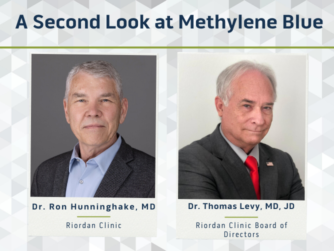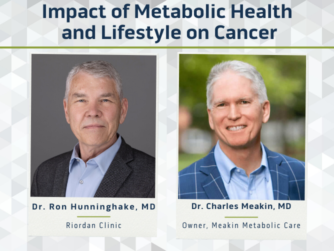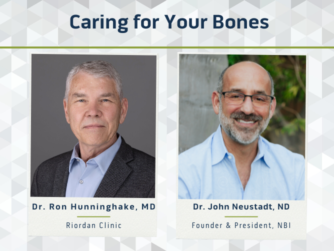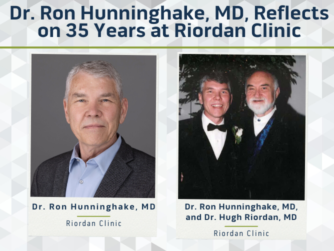In this episode of the Real Health Podcast, Chief Medical Officer Dr. Ron Hunninghake, MD, talks to Dr. Thomas Levy, MD, JD, and member of Riordan Clinic Board of Directors, about methylene blue. Originally created as a dye, methylene blue has been found to have powerful antioxidant properties beneficial in medical uses.
Thanks to this Episode’s Sponsor
Links
Learn more about the hosts: Dr. Ron Hunninghake: https://riordanclinic.org/staff/ron-hunninghake-md/
Dr. Thomas Levy, MD, JD: https://riordanclinic.org/staff/thomas-levy-md-jd/
Learn more about Riordan Clinic: https://riordanclinic.org/
Interested in becoming a Patient: https://riordanclinic.org/request-an-appointment/
Read the Transcript
Disclaimer: The information contained on the Real Health Podcast and the resources mentioned are for educational purposes only. They’re not intended as and shall not be understood or construed as medical or health advice. The information contained on this podcast is not a substitute for medical or health advice from a professional who is aware of the facts and circumstances of your individual situation. Information provided by hosts and guests on the Real Health Podcast or the use of any products or services mentioned does not create a practitioner patient relationship between you and any persons affiliated with this podcast.
Intro: This is the Real Health Podcast brought to you by Riordan Clinic. Our mission is to bring you the latest information and top experts in functional and integrative medicine to help you make informed decisions on your path to real health.
Dr. Ron Hunninghake: Well, hello everyone and welcome again to the Real Health Podcast. I’m your host, Dr. Ron Hunninghake. I’m the chief medical officer here at the Riordan Clinic, and today we have a real treat. Dr. Thomas Levy has joined us to talk. He’s a cardiologist, he’s an attorney, he’s a lifelong co-learner. He’s written a lot of books about nutrition and health, but today we’re going to talk about methylene blue. Can it help our brain? And so Dr. Tom, welcome to the Real Health Podcast.
Dr. Thomas Levy: My pleasure being here, sir.
Dr. Ron Hunninghake: Yeah. So how did you get interested in methylene blue?
Dr. Thomas Levy: Wow. A friend of mine about three months ago, not too long ago, mentioned that he had run across information on it, and he went to an office where they gave it. And I had heard of methylene blue before, but had never really looked into it. But I had such a high regard, have such a high regard from my friend’s intelligence and awareness on these issues that I just immediately jumped in and did a literature dive, and wow, every five minutes, another pearl was knocking me over. And it didn’t take too long before I came to the realization to my satisfaction that this was a powerful supplement, a powerful antioxidant, and the documentation in the literature and you know how significant this is coming from me.
Dr. Ron Hunninghake: Yeah.
Dr. Thomas Levy: Much of it rivaled the type of antioxidant power that vitamin C has exerted in the literature.
Dr. Ron Hunninghake: You about knocked me off my feet that day when you said, Dr. Ron, this may be something as good or maybe even better than vitamin C and I thought what the vitamin C guru? Are you changing religions here or what?
Dr. Thomas Levy: What I tell you. And I did mention this to you as well, hopefully at some point in time we can do a little bit of basic research because so far everything I’ve seen about methylene blue and what it does and how it does it. And from what I feel I know about vitamin C and its basic biochemistry, I think if you pushed a Guinea pig into scurvy and that’s a common animal, research animal that is easy to deprive of vitamin C, I think if you gave that Guinea pig clinical scurvy, I think you could pull it out of scurvy with methylene blue.
Dr. Ron Hunninghake: Right.
Dr. Thomas Levy: So I think they have that type of comparable effect, but of course, vitamin C doesn’t turn you blue. It doesn’t stain your toes. And so I’ve not,
Dr. Ron Hunninghake: It’s kind of a mess,
Dr. Thomas Levy: On vitamin C at all,
Dr. Ron Hunninghake: Yeah.
Dr. Thomas Levy: But my goodness, after I started doing the research on it, the documented effects it’s had, even on advanced COVID as a monotherapy and an advanced COVID individuals who were, a couple of case histories are covered in the article that I wrote, but suffice it to say on two different occasions and two different case reports, people who were in septic shock from COVID, basal pressures didn’t keep their blood pressure up. They were dying. And in the one case, the person coded and after they coded, they brought them back, started methylene blue, and the blood pressure started coming up, everything responded.
And what did they do? They stopped the methylene blue and then the patient coded again, and this time came back out of it. They kept the methylene blue up for a week, and the patient was subsequently discharged not too much longer. And another similar one just like that. And of course it begs the question, and we know the answer really it’s money, but it begs the question, why isn’t something like this a first line therapy? Why are they even throwing it in at the end just as the patient is on their last toe?
Dr. Ron Hunninghake: Yeah.
Dr. Thomas Levy: So but it’s like that we know with a lot of stuff. So hopefully we can just get the word out about methylene blue and it can be at least one great additional measure because everything is availability. Everything is availability. We have the forum now in the different areas that we write and talk about stuff, Dr. Ron, to get stuff, information out around the world. I get emails from patients and doctors from around the world, and they don’t even have ready access to vitamin C. They don’t have ready access to most of the vitamins and supplements that we have. But of all places in my adopted country where much of my extended family lives, Colombia, they’ve got methylene blue in the drugstore, in the drug area, the pharmacy for 35 cents. And,
Dr. Ron Hunninghake: Wow.
Dr. Thomas Levy: The individual that I was talking to down there did marvelous things with that, just as we would expect so from the literature. So it’s always important to get stuff that’s very inexpensive, very effective, without any significant side effects. And methylene blue only really gets you into trouble like just about anything else if you just completely and totally ignore a recommended dosing for different conditions.
Dr. Ron Hunninghake: Yeah. Yeah. What about the brain? Because that’s what really got my attention is that this stuff seems to cross the blood-brain barrier and get into the brain. And so if it acts a lot like vitamin C, there’s a lot of, matter of fact, I just finished a presentation on brain inflammation and wouldn’t this be a good thing to kind of help augment vitamin C in the brain?
Dr. Thomas Levy: Well, as a matter of fact, one of the early people who dealt with methylene blue, Paul Ehrlich referred to methylene blue as the magic bullet in this regard referring to the neurologic system because it’s so quickly targeted the neurologic system. Well, the thing that does that for the most part is the fact that methylene blue has both lipid soluble and water-soluble characteristics, unlike vitamin C, which is just water cycle. So it penetrates cell membranes very easily, and then once it passes the fatty cell membrane, it’s perfectly capable of disseminating well through the water-soluble intercellular environment. And as a pure observation, it’s been shown that when you take an intravenous dose of methylene blue, and for the most part I don’t think that’s necessary, but an intravenous dose of methylene blue within an hour, the concentrations are tenfold higher in the central nervous system than elsewhere.
So it really selectively goes in the nervous system. And anecdotally, although it is supported by a lot of literature, that’s happened since then. Anecdotally, some people have reported basically losing their depression after their first dose or two. So there’s very clear effects there. Very early on and it was shown that methylene blue was used for a lot of these things just empirically by doctors. And it turns out it has a chemical structure related to, but not to be confused as being the same as, related to phenothiazine, which is a central nervous system agent that’s been used for a long time. But obviously with these antioxidant properties, these redox properties is far more than just something that’s effective for depression. It’s effective everywhere in the body. But we always face the problem of how do we get the levels of the good stuff high enough in the brain and methylene blue does that manyfold.
Dr. Ron Hunninghake: How will methylene blue reduce inflammation in the brain? I mean, I know this gets into some redox chemistry, but what is it about methylene blue and vitamin C in terms of how they work together in the brain?
Dr. Thomas Levy: Well, that’s a good question and it’s something that needs to be emphasized, I think because we throw these, we, not we, the medical literature throws out the terms inflammation, oxidative stress, all this, and they’re generally valid observations. But it’s important to understand that if you have an area that is inflamed, you have an area that is vitamin C deficient, you have an area that is deficient of antioxidant status. And the other way of calling it focal scurvy, the point being is inflammation is nothing more than a focal depletion of item C and a focal depletion of vitamin C result in inflammation. They’re really basically synonyms.
So with that in mind, then it’s easy to see that even though vitamin C gets into the brain quite well, and in the healthy brain, you have probably 100 fold more concentration of vitamin C in the neurons than most of the other cells in the body. But let’s take the example of pathology though. We’re just talking about this. Let’s say somebody has not just depression, psychiatric problems, actual Parkinson’s, Alzheimer’s diseases, and we might already be pushing hard on the vitamin C and not really getting the result that we want. It’s incredible, probably due to the characteristics of methylene blue we just discussed. It gets into the brain in higher concentration and starts delivering that antioxidant impact that’s needed in those vitamin C deficient inflamed areas.
Dr. Ron Hunninghake: Yeah. So it’s basically acting as a kind of give and take in electrons in the brain, and that creates, we were talking about this earlier, that’s the basis of the electrical features of the living cell. And the brain is probably the most electrical part of the body. I mean, obviously all the body involves cellular electricity, but the brain and the neurons and the thinking and everything, we’ve got to have good control of electron flow if we’re going to be thinking properly and healing properly in the brain.
Dr. Thomas Levy: Yes, no doubt about it. And we’ve talked about this in some length, and even though you and I have been messing around with vitamin C infusions and everything for many years now, and of course they have wonderful results, we’ve kind of always just assumed, me included, of course, that the main role of vitamin C was to be given in a reduced electron rich form. And then by giving a large dose of vitamin C, you’re giving a large dose of electrons too. Well, yes you are, but that’s not the main impact. The main impact is you’re giving something that gives and takes, gives and takes, gives and takes, gives and takes, passes those electrons back and forth around the cells because we know, we have studies that show in clinical circumstances, situations a reduced form of vitamin C is just as effective, or I should say the oxidized form is just as effective as a reduced form.
Same thing for methylene blue. They’ve showed methylene blue just as effective in those septic shock patients in its oxidized form as its reduced form. So the thing is, is they’re not there. Vitamin C and methylene blue, their primary purpose is not to give you electrons anew, it’s to saturate the matrix of the cell with as much antioxidant capacity as well, so that the electron flow is optimized. And we’ve talked about electron flow, of course is current. And there’s measurable micro currents inside the cell, there’s measurable voltages across the cell membrane, and there’s worked out healthy micro currents and healthy voltages. And when you drop down below that, you get a sick cell, which is not surprising because it’s just reflecting, of course, a decreased antioxidant status. Just another measure of how effectively the new electrons you take in your diet are subsequently disseminated throughout the body.
Advertisement: There’s a lot more to this conversation, and it’s coming up right after a quick break. Today’s podcast is brought to you by LivOn Labs, makers of liposomal vitamins and supplements. LivOn uses liposomal encapsulation technology to protect nutrients from destruction in the digestive system. This allows for more efficient delivery of essential vitamins and nutrients. Choose from various supplements that support health and wellbeing such as lypo-spheric vitamin C, magnesium, glutathione, and more. To learn more, visit LivOn Labs, that’s L-I-V-O-Nlabs.com.
Dr. Ron Hunninghake: And also in terms of the brain, and this kind of ties into methylene blue, there’s a lot of theory about Alzheimer’s being related to chronic low grade infection in the brain. And you’ve talked a lot about how the biofilm in the nose could be feeding bacteria into the brain, and certainly the methylene blue has shown to have antifungal, antibacterial, antiviral properties. And so if you’re getting more of that in your brain, you may be helping to reduce at least the viral or infectious etiologies of chronic brain disease, Alzheimer’s or whatever.
Dr. Thomas Levy: And that’s a great point. And in fact, I think it would show up in most diseases, but they haven’t tested most diseases this way. They have a whole host of studies that show actual Alzheimer’s tissues often has biofilms and pathogens in it, typically from the mouth, porphyromonas gingivalis. Okay. So yes, they’re there. And having something that can potentially wipe it out is going to be a tremendous adjunct to just its general antioxidant capacity.
And they haven’t, to my knowledge, done the study yet, but I would be fascinated to see that if you were able to effectively clean out the mouth, we’ve always talked about the horrible contribution an infected mouth makes to your body, the root canals and the infected teeth and the tonsils and the gums. If you clean that up, I think if you gave a vigorous long term, not just short term, but vigorous long term, maybe, oh, I’m going to say a 100 milligrams a day for an extended period of time, you might actually start to see substantial clinical reversal of Alzheimer’s because the thing that sustains the Alzheimer’s is the brand new oxidative stress it gets every day from those pathogens. So if you can stop feeding those new sites with infectious from the mouth and then bring in something powerful like methylene blue that can wipe it out or really knock it down to a very low smoldering level, I think the potential clinical effects could be profound.
Dr. Ron Hunninghake: Mark Sloan’s book on methylene Blue, he quotes a study where they gave Alzheimer’s patients relatively low doses of methylene blue, and there was 85% improvement over the course of a year. So I think it’s something that, and I think there’s studies going on now, but they’re not out.
Dr. Thomas Levy: Well the thing they do, let me say this, they still approach Alzheimer’s as a irreversible disease, and that’s definitely not the case because I saw several cases of advanced Alzheimer’s, advanced reversed completely when enough dental toxicity was removed out of their mouth. I witnessed that in Dr. Hugger’s clinic. So the thing is, is we generally look upon Alzheimer’s, what can we do to diminish the symptomatology, make this out of the other, and that’s fine and good. But I think, I think if we really seriously knock out the dental toxicity and get an agent like methylene blue up there at a substantial dose on a regular basis, we might start seeing some marvelous medicine happen. Just saying.
Dr. Ron Hunninghake: That’s great. Hey, let’s just, for the audience, they’re probably wondering, how do you take this stuff? Because it is and isn’t,
Dr. Thomas Levy: Carefully.
Dr. Ron Hunninghake: Carefully. It’s a blue dye and it doesn’t come out of the clothes and the counters very easily. So what’s your approach? And I’ve got my approach, but I think the audience would like to know what’s a safe way and where do you get it? Do you need pharmaceutical grade? Let’s just do some practical discussion here.
Dr. Thomas Levy: You do need pharmaceutical grade. There’s a bunch of other laboratory agent grades. That’s not what you want. You need pharmaceutical grade, and it’s reflected in the price you. You’ll see the reagent grade, like 10% of the price of the pharmaceutical grade.
Dr. Ron Hunninghake: Yeah.
Dr. Thomas Levy: Well, there’s a reason for that, purity. So you want pharmaceutical grade, it mostly comes in a 1% concentration. It’s readily available on Amazon pre-made. And if you really, or if you start taking it and you decide it’s something you want to go in for the long term, it’s good to find the sources also available on Amazon of the powder where you can make your own by adding the purified water to it and then put it in storage in your refrigerator. That lasts a longer period of time because a stout dose of methylene blue is going to, for all intents and purposes, cost you $20 or $30 a month okay, or more depending on that dosage range.
Now, after a lot of trial and error, and we’ve talked a lot about this, as you well know, is the easiest way to take it so that the bitter taste is minimized, there is a bitter taste, the bitter taste is minimized, and there’s no significant blue staining is because if you just take the dropper and put it in some water and pop it down your mouth, you’re going to have a blue tongue. And if it catches your lips, you’re going to have blue lips and it might last a day or so. And that might not be something you want, but.
Dr. Ron Hunninghake: Especially not on a date.
Dr. Thomas Levy: But my own little formula, and we worked it out with you, is that it turns out that when you have the 1% solution and it’s dark, dark, dark, dark blue, and then let’s say it’s about oh, 50 CCs volume, the volume, and you just put a teaspoon of ascorbic acid, not sodium ascorbic, but ascorbic acid, and you found it works a little bit better with warm water, which is excellent idea.
Dr. Ron Hunninghake: The reaction goes faster is the only thing.
Dr. Thomas Levy: Yeah, it goes faster. And usually in five to 10 minutes or less, the solution has gone from an in impenetrable blue look to just a faint clear blue solution. Now, my little secret, because I’ve done a lot of staining by doing a lot of different mechanisms. So my little Levy modified intake is I like V8, and V8 is a nice thick thing. It doesn’t work as well with thin fruit juices. It can. So the V8 is, I have my syringe full of the methylene blue already. Okay. It is like syringe, and then I’ll put a little bit of V8 in a glass, throw it in my mouth, not swallow, just swish it around in my mouth, pour in another, put it in the methylene blue, and then while I still have the other in my mouth, swish that down and drink the whole thing.
And then follow it with another little swish of V8, and it gets it down with really no taste impediment and no significant staining. Now that’s just my little trick. There’s probably a lot of different juices you can try, vegetable juices, carrot juices, maybe some fruit juices. But this is more for minimizing the staining than it is the taste. I mean, if it was just the taste, I’m not that put off by the bitter taste that I just couldn’t take it and swallow it down like that. But I’m not fond of having the extended blue tongue for a long period of time.
Dr. Ron Hunninghake: Probably the last question I want to ask you is do you think this is safe for the average person to do on their own, or do you think they need to be having some kind of doctor’s supervision on this?
Dr. Thomas Levy: Oh no, I think it’s safe. Well, like anything else, I mean, people take stuff on their own all the time. I mean, they can take aspirin, and they can overdose on the aspirin. They can take the right dose of,
Dr. Ron Hunninghake: Overdose on water.
Dr. Thomas Levy: Aspirin or anything else. So as long as they follow the instructions, and it’ll probably be a trial by error where they realize how easy it is to do a little bit of staining. And let me say this. You said it right about the clothes. You get it on the clothes, the clothes are gone, you get it on your hands, a little rubbing alcohol, a little 3% hydrogen peroxide under the faucet, and you’ll get it off quickly, but don’t wait too long. Or you’re going to have the blue spots on your hands for about four or five days.
Dr. Ron Hunninghake: Yeah.
Dr. Thomas Levy: But the thing is, is no, I don’t see any danger in it. Any article, there’s some suggested doses for long-term maintenance and like any other agent, you can do a very minimal on the long term, five, maybe 10 milligrams a day. And if you’re fighting terminal COVID, you can be taken close to 200 milligrams a day. So it all works out differently there.
Dr. Ron Hunninghake: Would you quote where that article is that you did on methylene blue? That’s the Ortho Molecular News Service, is that right?
Dr. Thomas Levy: Right. Orthomolecular.org. Okay.
Dr. Ron Hunninghake: Orthomolecular.org.
Dr. Thomas Levy: And since it’s not listed by author that they need to go down the list and see the one that says entitled Resolving Colds to Advance COVID with Methylene Blue, it’s the volume 19 number eight, volume 19 number eight article.
Dr. Ron Hunninghake: And it’s an excellent article that goes deeply into the biochemistry and also the practical aspects as well. So Dr. Tom, thank you very much. I think this is going to be useful to a lot of people. And as always, you the man. So keep up the good work.
Dr. Thomas Levy: Thank you, sir.
Dr. Ron Hunninghake: All right.
Dr. Thomas Levy: Talk to you later. Take care.
Dr. Ron Hunninghake: Bye-bye.
Outro: Thank you for listening to the Real Health Podcast. If you enjoy this episode, be sure to subscribe and leave us a review. You can also find all of the episodes and show notes over at realhealthpodcast.org. Also, be sure to visit riordanclinic.org where you will find hundreds of videos and articles to help you create your own version of Real Health.







